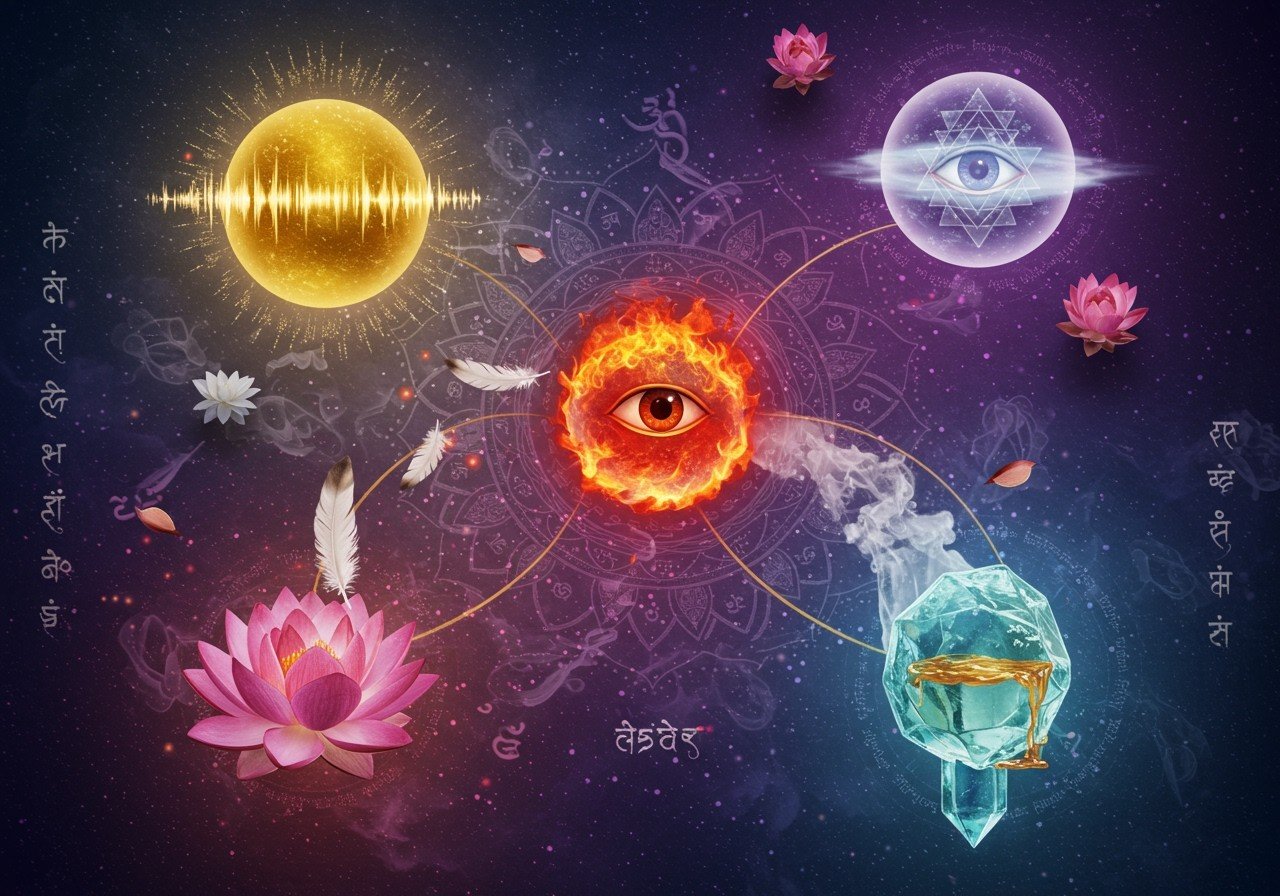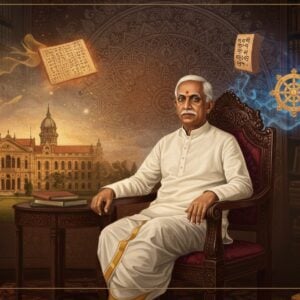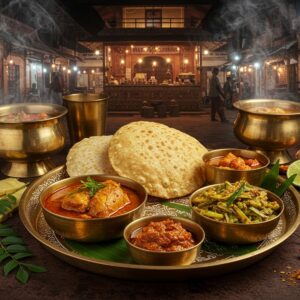Exploring Tanmatras: The Subtle Elements of Ayurveda and Samkhya

In the intricate world of Ayurveda and Samkhya philosophy, the concept of Tanmatras holds a significant place. These subtle elements bridge the gap between our physical senses and the spiritual essence of the universe. For those seeking a deeper understanding of traditional Indian practices, exploring Tanmatras offers insights into the connection between our senses and the elements, paving the way for balance and well-being. Delve into this exploration with us, and enrich your understanding of these foundational principles.
Understanding Tanmatras in Ayurveda
Tanmatras in Ayurveda are the subtle essences of the five elements. They are the precursors to sensory experience, represented by Shabda (sound), Sparsha (touch), Rupa (form/sight), Rasa (taste), and Gandha (smell). Each Tanmatra corresponds to a specific sense organ, creating a direct link between our perception and the external world.
- Shabda (Sound): This Tanmatra is associated with the sense of hearing and connects us to the element of ether (Akasha). It represents the subtle vibration that creates sound and allows us to perceive it through our ears. Maintaining a balanced Shabda Tanmatra contributes to healthy auditory function and mental clarity.
- Sparsha (Touch): Connected to the sense of touch and the element of air (Vayu), Sparsha represents the subtle sensation of pressure and texture. A balanced Sparsha Tanmatra contributes to healthy skin, tactile sensitivity, and the ability to connect with our environment.
- Rupa (Sight): Associated with vision and linked to the fire element (Agni/Tejas), Rupa is the subtle form of light and color that enables us to see. Balancing Rupa enhances visual clarity, supports eye health, and allows us to appreciate the beauty of the world around us.
- Rasa (Taste): This Tanmatra relates to the sense of taste and the water element (Jala/Apas). It represents the subtle flavors that we perceive through our tongue, influencing our enjoyment of food and our nutritional intake. A balanced Rasa Tanmatra supports healthy digestion and the appreciation of diverse flavors.
- Gandha (Smell): Connected to the sense of smell and the earth element (Prithvi), Gandha represents the subtle aromas and scents that we perceive through our nose. A balanced Gandha Tanmatra enhances our sense of smell, promotes respiratory health, and influences our emotional responses to scents.
These subtle elements play a crucial role in balancing the Doshas—Vata, Pitta, and Kapha—which are fundamental energies in Ayurveda. A deeper understanding of Tanmatras can lead to better management of these energies, promoting physical and mental harmony. This understanding enhances the effectiveness of Ayurvedic practices in daily life, aligning us with the natural rhythms of the universe.
Tanmatras in Samkhya Philosophy
Samkhya philosophy, one of the six schools of Indian philosophy, also places significant emphasis on Tanmatras. In this system, they are viewed as the subtle building blocks of the material world, emerging from the interaction of Purusha (consciousness) and Prakriti (nature). This interaction sets in motion the creation of the universe, with Tanmatras serving as the bridge between the formless and the manifest.
From these subtle Tanmatras, the five gross elements—Akasha (ether), Vayu (air), Tejas (fire), Jala (water), and Prithvi (earth)—evolve. Each element correlates with a specific sense, establishing a profound connection between our physical experience and the underlying metaphysical reality. This framework allows us to perceive the world through our senses, while acknowledging the deeper energetic forces at play.
Understanding Tanmatras within Samkhya offers insight into the evolution of the cosmos, from subtle energies to tangible forms. This understanding is crucial for both Ayurveda and Samkhya, illuminating the interplay of energy and matter that shapes our reality.
The Relationship between Tanmatras and Mahabhutas
The Mahabhutas, also known as the five great elements, have a profound connection with the Tanmatras. Each Tanmatra is the subtle precursor to a corresponding Mahabhuta, illustrating the evolution of energy into matter. This relationship is fundamental to sensory perception, explaining how we interact with the physical world.
- Shabda (Sound) and Akasha (Ether): Sound, the subtlest of the Tanmatras, gives rise to Akasha, the element of space. This connection explains how sound travels through space and how our sense of hearing perceives these vibrations.
- Sparsha (Touch) and Vayu (Air): Touch, the sensation of pressure and texture, is linked to Vayu, the element of air. This association reveals how we experience tactile sensations through the movement of air and the contact with our skin.
- Rupa (Sight) and Tejas (Fire): Sight, our ability to perceive light and color, is connected to Tejas, the element of fire. This link explains how light, a form of energy, allows us to see and how fire itself emits light.
- Rasa (Taste) and Jala (Water): Taste, the sensation of flavor, is associated with Jala, the element of water. This connection highlights how water acts as a medium for dissolving substances and carrying flavors to our taste buds.
- Gandha (Smell) and Prithvi (Earth): Smell, the perception of aromas and scents, is linked to Prithvi, the element of earth. This association illustrates how the earth holds and releases various scents, which we perceive through our sense of smell.
This relationship between Tanmatras and Mahabhutas forms the basis of our sensory experiences, explaining how we perceive and interact with the material world. In Ayurveda, understanding this connection is vital for maintaining balance and promoting holistic health.
Application of Tanmatras in Daily Life
Integrating the principles of Tanmatras into our daily lives can significantly enhance our overall well-being. Practices like aromatherapy and sound healing directly utilize the power of Tanmatras to create balance and harmony. These modalities harness the subtle elements of smell and sound to influence our mental and emotional states, promoting relaxation, focus, and inner peace.
Our daily diet, lifestyle choices, and meditation practices also play a vital role in balancing the Tanmatras. By making conscious choices aligned with these principles, we can enhance our physical and mental health. This can involve incorporating specific foods and aromas that stimulate and balance the senses, creating a harmonious flow of energy within the body and mind. These practices are deeply rooted in traditional Indian households, reflecting the cultural importance placed on holistic well-being.
Vedas – Ancient Wisdom for Modern Life – Practical Applications
Yoga & Ayurveda – A Holistic Wellbeing Approach
Mantra Chanting – Sound Vibration Healing Power
Tanmatras and the Mind-Body Connection
Tanmatras have a profound impact on the intricate relationship between the mind and body. By influencing our senses, they directly affect our mental states and emotional responses. Understanding this connection can empower us to better manage stress and anxiety, using sensory experiences to promote calmness and emotional stability.
By incorporating Tanmatras into meditation and mindfulness practices, we can cultivate mental clarity, enhance sensory awareness, and achieve emotional balance. This involves focusing on the subtle elements during meditation, deepening our connection to ourselves and the universe. These insights bridge the spiritual essence of the universe with our everyday experiences, offering a path to greater balance, well-being, and self-awareness.
How Poojn Supports Your Connection with Tanmatras
Poojn.in offers a wide selection of authentic ritual items to help you connect with the five Tanmatras. Explore their online platform for essential ingredients related to each subtle element, supporting your journey toward holistic well-being.
Gandha (Smell):
- Discover pure Haritaki (Harad) seeds, available in various quantities (100g to 900g), ideal for aromatherapy and ritual use. Green Mung Dal
- Find traditional aromatic items for sacred ceremonies, enhancing the sensory experience of your rituals. Supari (Areca Nut)
Rasa (Taste):
- Poojn.in provides premium quality Supari (Areca nut) in various pack sizes, ranging from 50g to 900g, ensuring you have the perfect amount for your needs. Large Size Elaichi (Black Cardamom)
- Source fresh Kala Til (Black Sesame) available in quantities from 25g to 1kg, supporting both culinary and ritual practices. Gulal Abeer (Five Color Abeer Gulal)
Every product at Poojn.in is accompanied by detailed descriptions and precise measurements to ensure an authentic experience. The platform combines the convenience of online shopping with doorstep delivery, while maintaining the sanctity and purity of these traditional items. Poojn.in sources all products from verified suppliers who prioritize quality and understand the significance of purity in spiritual practices.
Visit www.poojn.in to explore their comprehensive range of authentic ritual items that can enrich your spiritual journey through the Tanmatras.
Embracing Tanmatras in Modern Life
The concept of Tanmatras offers a timeless link between the spiritual and physical realms, deepening our understanding of life’s essence. In both Ayurveda and Samkhya philosophy, they unveil the intricate dance of elements that shape our universe and experiences. By embracing Tanmatras, we invite balance and harmony into our lives, seamlessly blending tradition with modern practices.
By integrating Tanmatras into our daily routines—whether through mindful meditation, sensory therapies, or conscious lifestyle choices—we nurture the vital connection between mind and body. These practices honor our cultural heritage, offering a path towards holistic health and well-being. As we continue this journey, we embrace the wisdom of our ancestors, integrating ancient insights into contemporary life, and cultivating a life filled with peace and purpose.
FAQs on Tanmatras in Ayurveda and Samkhya Philosophy
What are Tanmatras in Ayurveda? Tanmatras are subtle elements that form the foundation of our sensory experiences. They are sound, touch, sight, taste, and smell. They act as the bridge between our minds and the physical world.
How do Tanmatras relate to the Mahabhutas? Tanmatras are the precursors to the Mahabhutas (five great elements: ether, air, fire, water, and earth). Each Tanmatra evolves into a corresponding Mahabhuta, connecting our sensory perceptions to the physical elements.
Why are Tanmatras important in Samkhya Philosophy? In Samkhya, Tanmatras are crucial as they demonstrate the transition from the non-material to the material world. They help us understand how the universe develops from subtle energies to tangible forms.
How do Tanmatras influence our senses? Each Tanmatra directly corresponds to a specific sense organ. For instance, sound (Shabda) is linked to hearing, sight (Rupa) to seeing, and so on. They shape how we perceive the world around us.
Can Tanmatras affect our health? Yes, imbalances in Tanmatras can impact both physical and mental health, according to Ayurveda. Balancing these subtle elements can restore harmony between mind and body, improving overall well-being.
What role do Tanmatras play in meditation? Tanmatras can be points of focus during meditation to deepen the connection with oneself. Concentrating on these subtle elements enhances sensory awareness and mental clarity.
How does one balance Tanmatras in daily life? Practices like yoga, meditation, and a balanced diet help balance Tanmatras. Mindful engagement with nature and conscious living also support harmony.
Are Tanmatras connected to chakras? Yes, Tanmatras are linked to chakras (energy centers in the body). Each chakra resonates with specific Tanmatras, impacting our spiritual and physical well-being.


